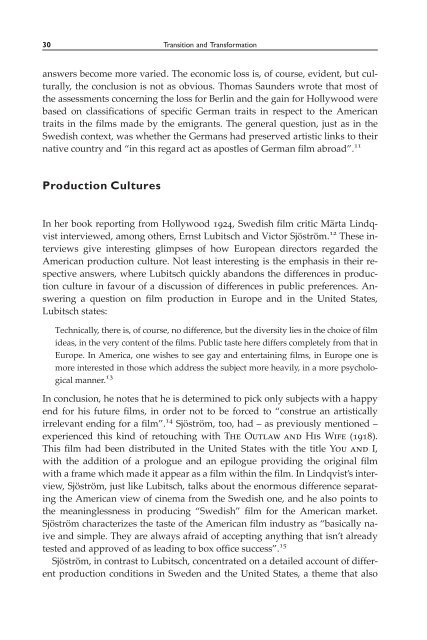FILM FILM - University of Macau Library
FILM FILM - University of Macau Library
FILM FILM - University of Macau Library
You also want an ePaper? Increase the reach of your titles
YUMPU automatically turns print PDFs into web optimized ePapers that Google loves.
30 Transition and Transformation<br />
answers become more varied. The economic loss is, <strong>of</strong> course, evident, but culturally,<br />
the conclusion is not as obvious. Thomas Saunders wrote that most <strong>of</strong><br />
the assessments concerning the loss for Berlin and the gain for Hollywood were<br />
based on classifications <strong>of</strong> specific German traits in respect to the American<br />
traits in the films made by the emigrants. The general question, just as in the<br />
Swedish context, was whether the Germans had preserved artistic links to their<br />
native country and “in this regard act as apostles <strong>of</strong> German film abroad”. 11<br />
Production Cultures<br />
In her book reporting from Hollywood 1924, Swedish film critic Märta Lindqvist<br />
interviewed, among others, Ernst Lubitsch and Victor Sjöström. 12 These interviews<br />
give interesting glimpses <strong>of</strong> how European directors regarded the<br />
American production culture. Not least interesting is the emphasis in their respective<br />
answers, where Lubitsch quickly abandons the differences in production<br />
culture in favour <strong>of</strong> a discussion <strong>of</strong> differences in public preferences. Answering<br />
a question on film production in Europe and in the United States,<br />
Lubitsch states:<br />
Technically, there is, <strong>of</strong> course, no difference, but the diversity lies in the choice <strong>of</strong> film<br />
ideas, in the very content <strong>of</strong> the films. Public taste here differs completely from that in<br />
Europe. In America, one wishes to see gay and entertaining films, in Europe one is<br />
more interested in those which address the subject more heavily, in a more psychological<br />
manner. 13<br />
In conclusion, he notes that he is determined to pick only subjects with a happy<br />
end for his future films, in order not to be forced to “construe an artistically<br />
irrelevant ending for a film”. 14 Sjöström, too, had – as previously mentioned –<br />
experienced this kind <strong>of</strong> retouching with The Outlaw and His Wife (1918).<br />
This film had been distributed in the United States with the title You and I,<br />
with the addition <strong>of</strong> a prologue and an epilogue providing the original film<br />
with a frame which made it appear as a film within the film. In Lindqvist’s interview,<br />
Sjöström, just like Lubitsch, talks about the enormous difference separating<br />
the American view <strong>of</strong> cinema from the Swedish one, and he also points to<br />
the meaninglessness in producing “Swedish” film for the American market.<br />
Sjöström characterizes the taste <strong>of</strong> the American film industry as “basically naive<br />
and simple. They are always afraid <strong>of</strong> accepting anything that isn’t already<br />
tested and approved <strong>of</strong> as leading to box <strong>of</strong>fice success”. 15<br />
Sjöström, in contrast to Lubitsch, concentrated on a detailed account <strong>of</strong> different<br />
production conditions in Sweden and the United States, a theme that also

















